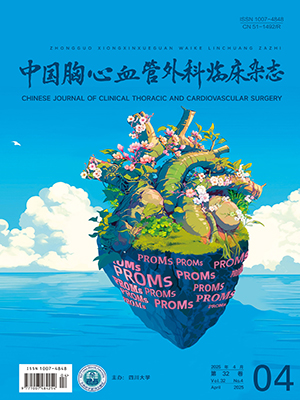| 1. |
Gaggero G, Valle L, Ferro J, et al. Type A aortic dissection. Autops Case Rep, 2021, 12: e2021346.
|
| 2. |
Sun L, Qi R, Zhu J, et al. Total arch replacement combined with stented elephant trunk implantation: A new "standard" therapy for type A dissection involving repair of the aortic arch? Circulation, 2011, 123(9): 971-978.
|
| 3. |
Ma WG, Zhang W, Wang LF, et al. Type A aortic dissection with arch entry tear: Surgical experience in 104 patients over a 12-year period. J Thorac Cardiovasc Surg, 2016, 151(6): 1581-1592.
|
| 4. |
Gong M, Wu Z, Xu S, et al. Increased risk for the development of postoperative severe hypoxemia in obese women with acute type A aortic dissection. J Cardiothorac Surg, 2019, 14(1): 81.
|
| 5. |
Song XC, Nie S, Xiao JL, et al. Risk factors and long-term prognosis for postoperative hypoxemia in patients with acute type A aortic dissection: A retrospective observational study. Medicine (Baltimore), 2022, 101(50): e32337.
|
| 6. |
Stephens RS, Shah AS, Whitman GJ. Lung injury and acute respiratory distress syndrome after cardiac surgery. Ann Thorac Surg, 2013, 95(3): 1122-1129.
|
| 7. |
Lai MY, Chu SM, Lakshminrusimha S, et al. Beyond the inhaled nitric oxide in persistent pulmonary hypertension of the newborn. Pediatr Neonatol, 2018, 59(1): 15-23.
|
| 8. |
Nakane T, Esaki J, Ueda R, et al. Inhaled nitric oxide improves pulmonary hypertension and organ functions after adult heart valve surgeries. Gen Thorac Cardiovasc Surg, 2021, 69(12): 1519-1526.
|
| 9. |
Duan XZ, Xu ZY, Lu FL, et al. Inflammation is related to preoperative hypoxemia in patients with acute Stanford type A aortic dissection. J Thorac Dis, 2018, 10(3): 1628-1634.
|
| 10. |
Sheng W, Le S, Song Y, et al. Preoperative nomogram and risk calculator for postoperative hypoxemia and related clinical outcomes following Stanford type A acute aortic dissection surgery. Front Cardiovasc Med, 2022, 9: 851447.
|
| 11. |
Wang Y, Xue S, Zhu H. Risk factors for postoperative hypoxemia in patients undergoing Stanford A aortic dissection surgery. J Cardiothorac Surg, 2013, 8: 118.
|
| 12. |
Rossaint R, Falke KJ, López F, et al. Inhaled nitric oxide for the adult respiratory distress syndrome. N Engl J Med, 1993, 328(6): 399-405.
|
| 13. |
Dellinger RP, Trzeciak SW, Criner GJ, et al. Association between inhaled nitric oxide treatment and long-term pulmonary function in survivors of acute respiratory distress syndrome. Crit Care, 2012, 16(2): R36.
|
| 14. |
El Kebir D, Hubert B, Taha R, et al. Effects of inhaled nitric oxide on inflammation and apoptosis after cardiopulmonary bypass. Chest, 2005, 128(4): 2910-2917.
|
| 15. |
Waldow T, Alexiou K, Witt W, et al. Attenuation of reperfusion-induced systemic inflammation by preconditioning with nitric oxide in an in situ porcine model of normothermic lung ischemia. Chest, 2004, 125(6): 2253-2259.
|
| 16. |
Lang JD, Smith AB, Brandon A, et al. A randomized clinical trial testing the anti-inflammatory effects of preemptive inhaled nitric oxide in human liver transplantation. PLoS One, 2014, 9(2): e86053.
|
| 17. |
Li Z, Zhang H, Baraghtha S, et al. Short- and mid-term survival prediction in patients with acute type A aortic dissection undergoing surgical repair: Based on the systemic immune-inflammation index. J Inflamm Res, 2022, 15: 5785-5799.
|
| 18. |
Xu H, Wang H, Wu L, et al. Prognostic value of systemic inflammation response index in acute type A aortic dissection. World J Surg, 2023, 47(10): 2554-2561.
|
| 19. |
Qin C, Zhang H, Gu J, et al. Dynamic monitoring of platelet activation and its role in post-dissection inflammation in a canine model of acute type A aortic dissection. J Cardiothorac Surg, 2016, 11(1): 86.
|
| 20. |
Al Sulaiman K, Korayem GB, Altebainawi AF, et al. Evaluation of inhaled nitric oxide (iNO) treatment for moderate-to-severe ARDS in critically ill patients with COVID-19: A multicenter cohort study. Crit Care, 2022, 26(1): 304.
|
| 21. |
Olsson C, Franco-Cereceda A. Impact of organ failure and major complications on outcome in acute type A aortic dissection. Scand Cardiovasc J, 2013, 47(6): 352-358.
|
| 22. |
Gebistorf F, Karam O, Wetterslev J, et al. Inhaled nitric oxide for acute respiratory distress syndrome (ARDS) in children and adults. Cochrane Database Syst Rev, 2016, 2016(6): CD002787.
|
| 23. |
Ri HS, Son HJ, Oh HB, et al. Inhaled nitric oxide therapy was not associated with postoperative acute kidney injury in patients undergoing lung transplantation: A retrospective pilot study. Medicine (Baltimore), 2018, 97(22): e10915.
|
| 24. |
Spina S, Lei C, Pinciroli R, et al. Hemolysis and kidney injury in cardiac surgery: The protective role of nitric oxide therapy. Semin Nephrol, 2019, 39(5): 484-495.
|
| 25. |
Gerlach H, Keh D, Semmerow A, et al. Dose-response characteristics during long-term inhalation of nitric oxide in patients with severe acute respiratory distress syndrome: A prospective, randomized, controlled study. Am J Respir Crit Care Med, 2003, 167(7): 1008-1015.
|
| 26. |
Yoshiyasu N, Sato M, Nakajima D, et al. Current status of inhaled nitric oxide therapy for lung transplantation in Japan: A nationwide survey. Gen Thorac Cardiovasc Surg, 2021, 69(10): 1421-1431.
|
| 27. |
Laube M, Amann E, Uhlig U, et al. Inflammatory mediators in tracheal aspirates of preterm infants participating in a randomized trial of inhaled nitric oxide. PLoS One, 2017, 12(1): e0169352.
|
| 28. |
Kamenshchikov NO, Duong N, Berra L. Nitric oxide in cardiac surgery: A review article. Biomedicines, 2023, 11(4): 1085.
|
| 29. |
Campelo AE, Cutini PH, Massheimer VL. Testosterone modulates platelet aggregation and endothelial cell growth through nitric oxide pathway. J Endocrinol, 2012, 213(1): 77-87.
|
| 30. |
Gries A, Bode C, Peter K, et al. Inhaled nitric oxide inhibits human platelet aggregation, P-selectin expression, and fibrinogen binding in vitro and in vivo. Circulation, 1998, 97(15): 1481-1487.
|




